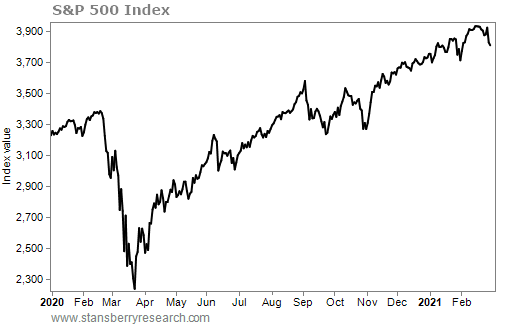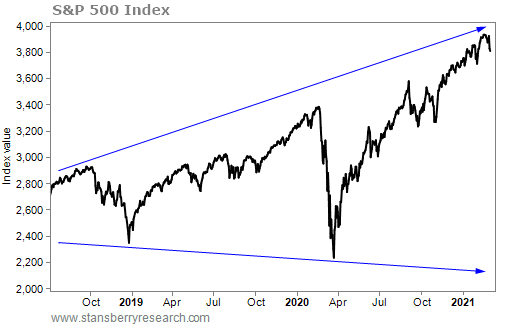Doc's note: "Last year's roller coaster ride isn't over yet," according to Extreme Value editor, Dan Ferris.
In today's issue, Dan explains why stocks are riskier today than they've been in 100 years and why you shouldn't expect your portfolio to keep on soaring higher from here...
***
What if one year ago, you knew that over the course of 2020, a pandemic would shut down much of the global economy – creating the steepest economic contraction since the Great Depression...
Thousands of restaurants and other businesses would close their doors – leaving millions of Americans unemployed and desperate...
Violent protests would occur in dozens of American towns and cities...
The stock market would hit a new all-time high in late February only to plunge 34% in about one month...
The U.S. Federal Reserve would cut interest rates effectively to zero and print roughly $3 trillion to support the economy and the financial system...
And Congress would sign off on an unprecedented $2 trillion stimulus package – mailing personal checks directly to people's homes.
Assuming you knew all this one year ago, what would have been your guess for the performance of various asset prices this year?
Probably nothing like what we got.
Today, the U.S. stock market is more expensive – and therefore riskier – than at any time in the past century. You must understand that risk... because last year's roller coaster ride isn't over yet...
The stock market soared 68% off its March bottom last year. Would you have thought new all-time highs were even a remote possibility after that precipitous drop?
Would you have thought that despite a raging pandemic, political upheaval, and civil unrest, stocks would surge to their most expensive valuation in history – even more expensive than the 1929 and 2000 market tops?

I've occasionally said that a wider range of outcomes for the price of a given asset indicates higher risk. For example, there's a much wider range of outcomes for small-cap mining stocks (which can soar hundreds, even thousands of percent – or collapse entirely) than for Treasury bonds (which pay roughly 1% a year for 10-year bonds today).
The stock market has made higher highs since I got bearish in 2017... But it has also made lower lows. In other words, a wide range of outcomes occurred.
The more expensive stocks become, the riskier they are to own. And that's what we're seeing today...

The best two metrics to demonstrate how expensive stocks are today are the S&P 500 price-to-sales (P/S) ratio and the ratio of total U.S. market cap to U.S. gross domestic product ("GDP").
Over the past century or so, whenever the P/S ratio has been high, the market has tended to perform poorly, sometimes for many years. At the peak of the dot-com bubble in March 2000, the P/S ratio was 2.3. Today, it's about 2.8.
The total market-cap-to-GDP ratio was pioneered by value guru Benjamin Graham and often cited by his prized pupil, Warren Buffett. It, too, has never been as high as it is today. It peaked at 140% in 2000 and 105% in 2007. Now it's 190%.
I also follow the stock market valuation work of economist and asset manager John Hussman of HussmanFunds.com. He tracks five metrics, including the P/S ratio, that have all correlated negatively over the past century with subsequent 10- and 12-year S&P 500 performance. Roughly 90% of the time when they've been high, the S&P 500 has performed poorly for a decade.
In a recent market comment, Hussman wrote...
Presently, I expect that the completion of this market cycle is likely to involve a loss in the S&P 500 on the order of 65-70%. I realize, of course, that this sounds insane. The problem is that this projection is fully in line with a century of evidence and is consistent with the extent of market losses that would be run-of-the-mill given present valuation extremes.
Hussman estimates that a portfolio of 60% S&P 500 stocks, 30% long-term Treasury bonds, and 10% Treasury bills will lose 1.7% per year for the next 12 years. He estimates the S&P 500 by itself will lose 3.6% per year for the next 12 years.
Asset manager Jeremy Grantham's firm, GMO, has studied a couple dozen asset bubbles throughout history. It also publishes seven-year return forecasts for various asset classes. Grantham recently called the current market a "'real McCoy' bubble" and added, "It's truly crazy."
GMO's seven-year annual return estimates for all U.S. equities and bonds, international large-cap equities, and international bonds are negative. Its only attractive forecast is for value stocks in emerging markets, at 9.1% per year.
With stocks more overvalued than at any time in the past century, it's time to plan accordingly. Risk is high today... And we'll likely see years of underperformance when this bull market ends.
Good investing,
Dan Ferris
Editor's note: Dan has shown readers gains of 628% and 406% in the last few years... along with open gains as high as 600%. But he says that one regular stock could outperform all those gains and become his legacy. It's his No. 1 idea of all time – "hands down." But his research shows you must act quickly. Click here to learn more.
